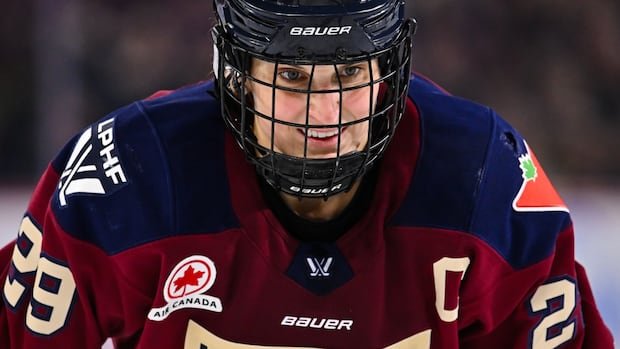
This is an excerpt from The Buzzer, which is CBC Sports’ daily email newsletter. Stay up to speed on what’s happening in sports by subscribing here.
It’s never been a better time to be a women’s hockey fan.
The PWHL appears to be on solid footing heading into its third season, with expansion teams in Vancouver and Seattle growing billionaire Los Angeles Dodgers owner Mark Walter’s league to eight teams. And with the Winter Olympics coming up, we can look forward to another thrilling gold-medal clash between archrivals Canada and the United States this February in Italy.
As players prepare for a busy 2025-26 season that also includes a four-game Rivalry Series between the Canadians and Americans, my CBC Sports colleague Karissa Donkin has published an excellent new book about the PWHL. Breakaway: The PWHL and the Women Who Changed the Game chronicles the birth of the league and its inaugural 2024 season through the eyes of some key figures. Those range from superstar Marie-Philip Poulin to her Montreal coach Kori Cheverie to PWHL Players’ Association leader Liz Knox, a former goalie who once worked a day job as a roofer while playing in the cash-strapped Canadian Women’s Hockey League.
I recently sent Karissa some questions about the current state of the PWHL and women’s hockey in general. Here are her thoughts:
Your book ends in September 2024 with the PWHL preparing for its second season. A year later, what would you say were the biggest changes in season two? Other than the new team nicknames, logos and uniforms.
I think a lot of the focus shifted to the actual hockey last season. We talked a lot in season one about so many milestones and big firsts. But as the league marked its first birthday, all of the chatter was around a major hockey trade between the Toronto Sceptres and Ottawa Charge.
Historically, there has been a lot more coverage about league building, about stops and starts, rather than the hockey being played. Players have spent a lot of time talking about inequity. Finally, we’re talking about hockey.
Stan Kasten, the Dodgers president who helped Walter get the PWHL off the ground, warned the players that the league was going to screw some things up in the first season. What do you think they screwed up?
There were lots of bumps along the way in that first season, from scrambling to find venues and hire staff at a record pace, to keeping enough merchandise in stock, to playing without team names or logos. (Though you could argue no team names and logos wasn’t the worst thing for the league, which saw a second bump in merchandise sales when those were unveiled).
The biggest misstep might have been putting a team in New York that ultimately split its home games in that first season between three states and failed to gain traction. The Sirens seem to have found a more permanent home in New Jersey, but there’s still a long way to go to establish a strong fanbase for that team.
How do you think the two expansion teams will work out? And when and where do you foresee the next expansion happening?
There’s been strong fan interest so far for the new teams in Vancouver and Seattle, the latter of which has always been a women’s sports city. And there’s no question both teams will be competitive on the ice, after swiping some of the most talented young players in the league from existing teams. Every first-round draft pick from 2024, except for New York’s Sarah Fillier, will play for Seattle or Vancouver this upcoming season. But players in the PWHL still fly commercially during the regular season, so I’ll be interested to see how the added travel to the west coast plays out.
I think the next round of expansion will come very soon. When the first expansion team in Vancouver was announced, the PWHL’s executive vice president of business operations, Amy Scheer, said it was just step one in a multi-year plan to grow the league, which is still seeking a major U.S. broadcast rights deal.
It wouldn’t be surprising for the league to continue to add teams in the west. Edmonton and Denver would make a lot of sense geographically. Both of those cities hosted successful stops on the league’s Takeover Tour last season, with Rogers Place in Edmonton selling out and more than 14,000 fans showing up in Denver.
This February will bring the first Winter Olympics of the PWHL era. Given how vital the Canada-U.S. rivalry has been to the growth of women’s hockey, how do you think the rise of the PWHL might affect it?
Some people question whether the rivalry is still strong, given how many players compete together on PWHL teams. I can promise you that it’s still as heated as ever! These players are not friends on the ice when it comes to Canada vs. the U.S.
But we’ve already started to see the PWHL impact international hockey. For one, Canadian team hopefuls no longer centralize in one location for several months ahead of the Olympics. Number two, league play has become the top evaluation tool for players hoping to make the team. Look no further than players like Sophie Jaques, Kati Tabin and Daryl Watts, who’ve earned invites to Olympic training camp based on strong performance in the PWHL.
We haven’t yet seen the gap between Canada, the U.S. and the rest of the world close in a meaningful way. But we have seen steady progress for countries like the Czech Republic. For the first time, a European player, Czech forward Kristyna Kaltounkova, was the first overall pick in the PWHL draft. It wouldn’t be surprising to see talented Slovakian teen Nela Lopusanova follow in her footsteps in a few years.
One of the goals in creating the PWHL was to find a way to get the best players in the world in one league for the first time. Eventually, that’s bound to help level the playing field internationally.
Source link




